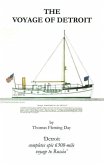"I have found every word of Voss's concerning ships and the sea to be pure gold."--Weston Martyr, sailing author On May 27, 1901, Captain John C. Voss, accompanied by journalist Norman Luxton, put to sea in the "Tilikum," a 38-foot dugout canoe. Joshua Slocum's best-sell, "Sailing Alone Around the World," had been published the year before, and Voss and Luxton's goal was to make a name for themselves by circling the globe in a vessel smaller than Slocum's "Spray." "Tilikum" was just 5 feet wide and drew a mere 24 inches fully loaded. Outfitted by Voss with a deck, a small keel, three stubby masts, a cockpit for the helmsman, and a tiny cabin, Voss's canoe was one of the oddest craft ever to attempt a deep-sea voyage. Her crew, too, was mismatched. Voss was a professional sailor who had been pushed ashore by the decline of commercial sail. Luxton, a nautical innocent, was along to record the voyage for posterity. More than three years later, "Tilikum" arrived in England after a voyage of 40,000 miles--a journey fraught with perilous and exotic adventures on both land and sea. Luxton abandoned the boat in the South Seas, and his replacement was lost overboard in a storm. But Voss carried on, and in 1912 - 13 he wrote "The Venturesome Voyages of Captain Voss," the book that established him alongside Slocum as one of the greatest small-boat navigators of all time. This volume in The Sailor's Classics restores in its entirety Captain Voss's account of his adventure in the "Tilikum," together with the more noteworthy of the two remaining narratives in Voss's original book, a voyage through a typhoon in the 19-foot yawl "Sea Queen." In the words of Jonathan Raban, "to possess thisbook is to have at your elbow your own compact fount of growling sea-wisdom, "the" classic primer on small-boat handling under all imaginable conditions." For sailors and armchair adventurers alike, "40,000 Miles in a Canoe" is an unforgettable read. "It is the voice of Captain Voss that stops you in your tracks, like Coleridge's wedding guest detained by the Ancient Mariner; a gruff, bewhiskered, seadog's voice, rich in experience and personality. There's liquor on his breath, and a singular glitter in his eye."--from the introduction by Jonathan Raban Captain John C. Voss is, without a doubt, one of the most colorful and controversial figures in 20th-century nautical history. During his lifetime, and for many years thereafter, he was labeled an adventurer, thief, saint, charlatan, even murderer. But one thing that Voss's friends and detractors alike agreed upon without reservation was his genius for practical seamanship. This volume in The Sailor's Classics presents two epic, salt-encrusted sea tales from Voss's 1913 book, "The Venturesome Voyages of Captain Voss." "40,000 Miles in a Canoe" is the unforgettable account of his three-year voyage across three oceans in a Native American dugout canoe modified for sail. In "Sea Queen," Voss and his crew survive a monstrous typhoon in a tiny 19-foot yawl. This book is not just great storytelling, it is also the classic primer on small-boat seamanship.
Hinweis: Dieser Artikel kann nur an eine deutsche Lieferadresse ausgeliefert werden.
Hinweis: Dieser Artikel kann nur an eine deutsche Lieferadresse ausgeliefert werden.








